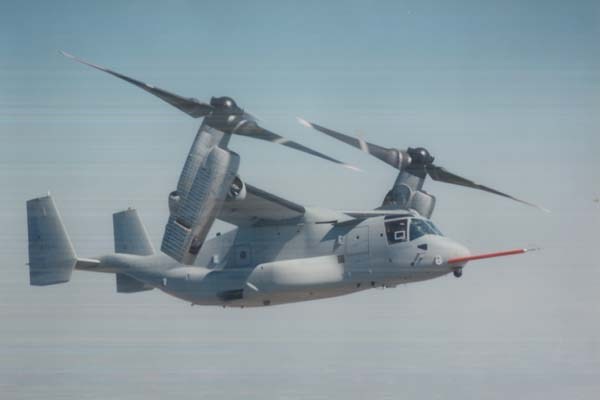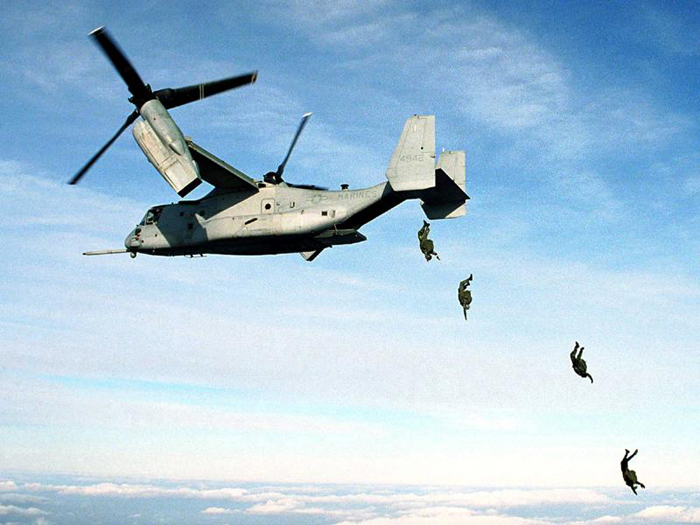V-22 Osprey: Controversial Dream Machine | The Most Amazing Flying Machines Ever
This is part of a SPACE.com series of articles on the Most Amazing Flying Machines Ever, the balloons, airplanes, rockets and more that got humans off the ground and into space.
Combining the vertical takeoff and landing capabilities of a helicopter with the long-range, high-speed, and high-altitude capabilities of a turbo-prop airplane, the V-22 Osprey represents a dream of aircraft designers for generations.
The V-22 Osprey is a tilt-rotor aircraft that takes off and lands vertically like a helicopter and flies like a plane by tilting its wing-mounted rotors to function as propellers. The V-22 has a cruising speed of 218 mph (350 km/h), twice as fast as a typical helicopter.
The V-22 is self-deployable worldwide, meaning it can fly long distances and not always have to be transported on an aircraft carrier to be in range for a mission. It can ferry troops and equipment more than 2,000 miles (3,200 km), though normal operating range is 1,000 miles (1,600 km). It can transport 24 combat troops, 20,000 pounds of internal cargo, or up to 15,000 pounds of external cargo. For easy storage aboard an aircraft carrier or assault ship, its wings can be rotated and its rotors can fold to minimize its footprint. The V-22 can be refueled in midair.
History
The V-22 program was begun in 1981. After the failure of the Iran hostage rescue mission in 1980, the U.S. military realized it needed a "new type of aircraft." Bell Helicopter partnered with Boeing Vertol to propose an enlarged version of the Bell XV-15 prototype. Full-scale development of the V-22 began in 1986.
The first V-22 rolled out in May 1988. There were two variants. The Marine Corps version was designed the MV-22, and the Air Force variant was designated CV-22. The Navy and the Army also had plans for their own versions.
Breaking space news, the latest updates on rocket launches, skywatching events and more!
But the V-22's future was soon called into question. Secretary of Defense Dick Cheney sought — four times in four years — to cancel the program on grounds of affordability. The Army bowed out. The Department of Defense instructed the Navy not to spend any more money on the V-22. Congress continued to fund the program, however. Later, the Clinton administration was more supportive and kept the program funded.
Cost overruns plagued the V-22's development. The development budget in 1986 was $2.5 billion. It was increased to $30 billion in 1988. In 2001, the V-22 squadron's commander, Marine Corps Lt. Col. Odin Lieberman, was relieved of duty after allegations that he ordered his unit to falsify maintenance records to make the aircraft appear more reliable. Three other officers were also implicated.
There were numerous safety concerns as well. During testing from 1991-2000, V-22 aircraft crashed seven times, resulting in 36 deaths. The V-22 was grounded after each crash while improvements were made. The Pentagon declared the Osprey “operationally suitable” in September 2005 and called for full production.
Since then, the V-22 has been deployed to Iraq, Afghanistan and Libya. In 2010, and Osprey was sent to Haiti to aid relief efforts after an earthquake. As of February 2012, 160 aircraft have been built, with a total of 408 planned. The aircraft remains controversial, but for now, it is the military's dream machine.
— Tim Sharp, Reference Editor
Related:
The Greatest Moments in Flight
- The First Hot-Air Balloon
- The First Powered Airship
- The Wright Brothers & the First Flight
- World's First Commercial Airline
- Charles Lindbergh & the First Solo Transatlantic Flight
- Breaking the Sound Barrier
- The First Man in Space
- Apollo 11: First Men on the Moon
- Salyut 1: The First Space Station
The Most Amazing Flying Machines Ever
- The First Airplane: Wright Flyer
- The Red Baron & Aerial Weapons of World War I
- The Zeppelin Hindenburg: When Airships Ruled
- The First Fighter Jet: Me 262 Schwalbe
- SR-71 Blackbird: Supersonic Spy Aircraft
- Saturn V Rocket & Apollo Spacecraft
- Space Shuttle: The First Reusable Spacecraft
- International Space Station
- SpaceShipOne: First Private Spacecraft
Image galleries:



